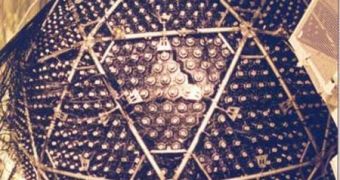Antarctica is host to a very powerful observatory, a neutrino telescope buried deep under its ices. The instrument's main function is to detect the elusive elementary particles, but experts found that it could also provide them with an in-depth look at the temperature variations taking place in the ozone layer, Technology Review reports. The observation post is called the IceCube Neutrino Observatory, and it features a wide array of photon detectors, buried under the ices of the South Pole. Neutrino detectors are usually constructed inside underground caves or abandoned mines.
The reason why the Antarctic arrays are buried is relatively simple. As neutrinos pass through the ice at amazing speeds, they sometimes slam into atoms, generating another type of elementary particles, namely muons. These particles in turn emit light as they go through the ice, which allows the photon detectors making up IceCube to detect them, and measure several of their properties before they completely decay.
The main problem with the observatory is that the vast majority of muons that is detected is generated by cosmic rays interacting with the upper atmosphere, rather than neutrinos slamming into various atoms. Each neutrino-generated muon corresponds to several million cosmic-ray-generated ones.
IceCube Collaboration expert Serap Tilav and his team have been using various types of filters to weed out this unwanted “noise” since the project started, but they have recently realized that they may have misinterpreted the cosmic-ray-generated muons. These elementary particles are apparently very tightly linked to the temperature of the ozone layer right above the South Pole. All along, the team now says, the observatory has been acting like a giant thermometer, but the researchers have been suppressing this ability because they have been looking for something else.
Another coincidence that is very useful is the fact that the IceCube appears to be more suited at detecting muons during the winter, which is nothing but good news. The US National Oceanic and Atmospheric Administration (NOAA) is constantly surveying polar temperatures via the NASA Polar Orbiting Environmental Satellites, and balloon-born radiosondes. But, during the winter, sending the balloons is impractical, so the neutrino observatory could turn out to be just what NOAA needs to keep conducting all-year-long observations in Antarctica.

 14 DAY TRIAL //
14 DAY TRIAL //